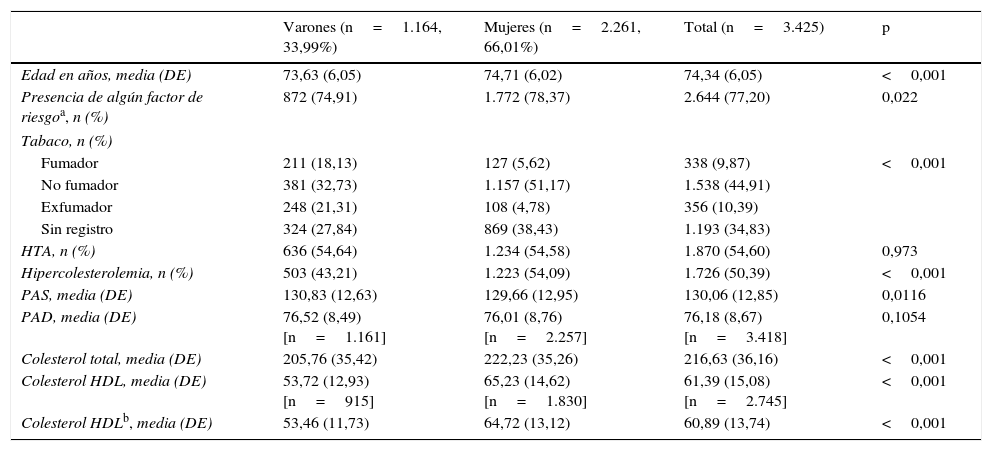Una de las limitaciones del SCORE es que no permite calcular el riesgo en mayores de 65 años. Recientemente, los investigadores del SCORE han publicado unas tablas específicas para mayores (SCORE Older Persons [SCORE OP]). El objetivo del presente estudio fue evaluar el impacto de la utilización de las tablas SCORE OP en una población española de pacientes mayores de 64 años y su comparación con las tablas SCORE en el grupo entre 65 y 69 años.
Pacientes y métodoEstudio transversal realizado en 2 centros de salud urbanos. Se seleccionaron individuos de entre 65 y 85 años sin antecedentes de diabetes mellitus o enfermedad cardiovascular. Se calculó el riesgo utilizando las tablas para países de bajo riesgo SCORE y las nuevas OP.
ResultadosSe calculó el riesgo cardiovascular a 3.425 pacientes. En el grupo de entre 65-69 años (n=974, 22,44%) la media de riesgo según el SCORE fue de 4,08, y según el SCORE OP, de 3,83 (p<0,001). El porcentaje de pacientes de riesgo alto fue de un 25,46% con SCORE y de 22,90% con SCORE OP (p<0,001). Utilizando el SCORE deberíamos tratar con hipolipidemiantes al 16,43% de los pacientes, mientras que con el SCORE OP deberíamos tratar al 13,45%. Utilizando SCORE OP en pacientes mayores de 69 años deberíamos tratar con hipolipidemiantes al 61,49% de los pacientes.
ConclusionesLas tablas SCORE OP para mayores de 64 años identifican menos pacientes de alto riesgo que las tablas SCORE, lo que implicaría tratar potencialmente menos pacientes de esas edades con hipolipidemiantes.
Estimating cardiovascular risk with SCORE is not recommended in persons over 65 years. SCORE investigators have recently published specific tables for older people (SCORE Older Persons [SCORE OP]). The aim of this study is to assess the impact of using SCORE OP tables on a Spanish population aged over 64 years, and compare it with the use of SCORE in patients aged 65-69 years.
Patients and methodCross-sectional study carried out in 2 urban primary health care centres. Individuals between 65 and 85 years old without diabetes or established cardiovascular diseases were included. Cardiovascular risk using SCORE and the new SCORE OP tables for low risk countries was calculated.
ResultsCardiovascular risk was estimated in 3,425 patients. Mean values of the original SCORE and SCORE OP were 4.08 and 3.83, respectively in the group of patients aged 65-69 years old (n=974, 22.44%) (P< .001). The percentage of patients at high or very high risk was 25.46% and 22.90% with the original SCORE and the SCORE OP, respectively (P<.001). Using the original SCORE, 16.43% of the total patients should potentially be treated with lipid lowering drugs, while using the SCORE OP, 13.45% of the patients aged 65-69 years should potentially be treated. Using SCORE OP in patients older than 69 years, 61.49% patients should potentially be treated with lipid lowering drugs.
ConclusionsSCORE OP identifies fewer patients at high or very high risk than the original SCORE, therefore, its utilization would imply treating fewer patients of this age with lipid lowering drugs.
Artículo
Comprando el artículo el PDF del mismo podrá ser descargado
Precio 19,34 €
Comprar ahora












